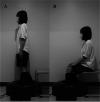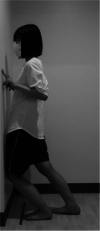Characteristics of hindfoot morphology and ankle range of motion in young women with hallux valgus
- PMID: 37749634
- PMCID: PMC10519086
- DOI: 10.1186/s13047-023-00666-4
Characteristics of hindfoot morphology and ankle range of motion in young women with hallux valgus
Abstract
Background: Hallux valgus occurs more frequently in women as they age; therefore, it is beneficial to prevent hallux valgus in younger women. The purpose of this study was to clarify the characteristics of hindfoot morphology and the range of motion of the ankle joint with hallux valgus in young women.
Methods: The participants were 140 young women (mean age 18.8 ± 0.6 years). A three-dimensional footprint automatic measurement apparatus was used to measure the hallux valgus angle in the standing position and the arch-height ratio and heel-floor angle (HFA) in the standing and chair-sitting positions. The amount of change in foot morphology owing to differences in posture was calculated. The range of motion of the ankle joint dorsiflexion, plantarflexion, inversion, and eversion was measured. Participants were classified into two groups according to the presence of hallux valgus. Statistical analysis was used to compare hindfoot morphology and range of motion between the two groups, and the correlation between foot morphology and range of motion was investigated depending on the presence of hallux valgus.
Results: With hallux valgus, the HFA tilted inwards (p = 0.010), and the change in the arch-height ratio due to the difference in posture was large (p = 0.021). There was no difference in the range of motion of the ankle joints with or without hallux valgus. In women with hallux valgus, the amount of change in arch height and HFA was correlated with the range of motion of eversion (r = 0.391, p = 0.027; r = -0.362, p = 0.042).
Conclusions: With hallux valgus, the hindfoot pronated, and the arch height decreased from sitting to standing. Furthermore, the amount of change in the hindfoot and midfoot due to posture was related to the range of motion of eversion.
Keywords: Ankle; Hallux valgus; Morphology; Posture; Pronation.
© 2023. The College of Podiatry and the Australasian Podiatry Council.
Conflict of interest statement
The authors declare that they have no competing interests.
Figures





Similar articles
-
Relationship between foot morphology, muscle strength, and physical performance test in women aged 65 years and older: a cross-sectional study.BMC Musculoskelet Disord. 2022 Nov 18;23(1):995. doi: 10.1186/s12891-022-05962-x. BMC Musculoskelet Disord. 2022. PMID: 36401220 Free PMC article.
-
Individuals with asymptomatic hallux valgus exhibit altered foot kinematics during gait regardless of their foot posture.Clin Biomech (Bristol). 2024 Aug;118:106319. doi: 10.1016/j.clinbiomech.2024.106319. Epub 2024 Aug 2. Clin Biomech (Bristol). 2024. PMID: 39106589
-
Mild-to-Moderate Hallux Valgus Does Not Decrease Ankle Muscle Strength in Middle-Aged Japanese Women: A Comparative Study.J Foot Ankle Surg. 2018 Nov-Dec;57(6):1157-1160. doi: 10.1053/j.jfas.2018.06.013. Epub 2018 Sep 20. J Foot Ankle Surg. 2018. PMID: 30243790
-
Hindfoot alignment of hallux valgus evaluated by a weightbearing subtalar x-ray view.Foot Ankle Int. 1999 Oct;20(10):640-5. doi: 10.1177/107110079902001005. Foot Ankle Int. 1999. PMID: 10540995
-
Biokinetic Evaluation of Hallux Valgus during Gait: A Systematic Review.Foot Ankle Int. 2023 Aug;44(8):763-777. doi: 10.1177/10711007231166667. Epub 2023 Apr 21. Foot Ankle Int. 2023. PMID: 37086002
References
MeSH terms
Grants and funding
LinkOut - more resources
Full Text Sources

